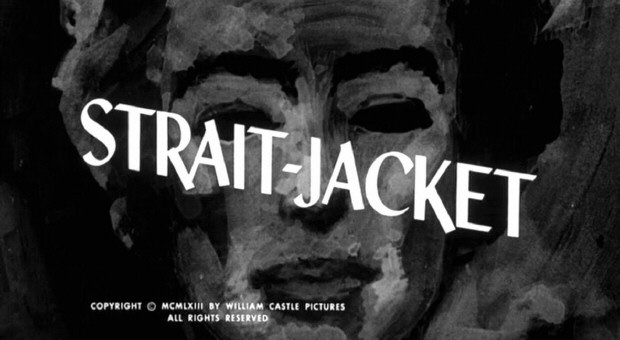
The Best of Everything
Encyclopedia Entry • Films Main
Strait-Jacket
1964

Critics' Reviews • Our Reviews • Movie Posters • Lobby Cards • Misc.
Click here to see photos from the film.
|
Columbia. 93 minutes. US release: 1/22/64. (In production, August '63.)
VHS release: 1/19/99. DVD release: 3/12/02. Blu-ray release (solo): 8/21/18. Blu-ray release (part of "Psycho Biddy Double Feature" with Berserk): 9/25/18. Cast: Joan Crawford (as "Lucy Harbin"), Diane Baker, Leif Erickson, Howard St. John, John Anthony Hayes, Rochelle Hudson, George Kennedy, Edith Atwater, Mitchell Cox (a Pepsi exec specially invited by Joan to appear as the doctor), Lee Yeary, Patricia Krest, Vachel Cos, Patty Lee, Laura Hess, Robert Ward, Lyn Lundgren. Credits: Screenplay: Robert Bloch. Producer/director: William Castle. Camera: Arthur Arling. Editor: Edwin Bryant. Music: Van Alexander. Plot Summary: In this chilling blood-tale in "Psycho" style, Robert Bloch modernizes the Lizzy Borden story. A wife (Joan Crawford) literally axes her cheating husband and his lover, witnessed by her three-year-old daughter. Mom is packed off to the insane asylum for 20 years before reuniting with the daughter (Diane Baker). From this point, the axe murders continue along a contrived plot intended to lead the audience astray until the mystery is solved. Crawford's strong performance and the excellently constructed suspense are the best elements of the film -- and the chopping saves the show when the plot tends to slow. ~ Lucinda Ramsey, All Movie Guide |
Bosley Crowther in the New York Times January 23, 1964
Joan Crawford has picked some lemons, some very sour lemons, in her day, but nigh the worst of the lot is "Strait-Jacket," in which she showed up at neighborhood theaters yesterday. In this disgusting piece of claptrap, she allows herself to play a middle-aged woman and mother who returns to her daughter after spending 20 years in an insane asylum, where she has been atoning for chopping the heads off her faithless husband and his light o' love. Although she wants to be a nice old lady, her daughter cons her into buying a black wig, donning a slinky flowered dress, a jangle bracelet and trying to look exactly the way she did the night she wielded the ax. In this ridiculous get-up, she reverts to type (we are led to suppose), and three more heads are rudely sliced off shoulders by axes wielded in the dark before an absurd bit of criminal abnormality is exposed. The story is utterly invalid, psychologically and dramatically, and William Castle's direction and production are on the cheapest, sleaziest side. The only conceivable audience for this piece of melodramatic rot is those who have a taste for ghoulish violence (of which there is plenty) and blunt shock-effected thrills. Time (1964): It must also be the first horror film to boast that one of its diehard victims (Mitchell Cox) is a real life Vice President of the Pepsi-Cola Company. As for Pepsi-Cola Board Member Crawford, she plainly plays her mad scenes For Those Who Think Jung.
Judith Crist in the New York Herald Tribune (1964): Strait-Jacket should be subtitled What Ever Happened to Baby Monster? and there's a clue for you. [It] proves that lightning does not strike twice and that it's time to get Joan Crawford out of those housedress horror B movies and back into haute couture. Miss Crawford, you see, is high class. Too high class to withstand in mufti the banality of Robert Bloch's script, cheap-jack production, inept and/or vacuous supporting players and direction better suited to the mist-and-cobweb idiocies of the Karloff school of suspense. These make a disappointing low-level melodrama of this madness-and-murder tale that might have been a thriller, given Class A treatment....Miss Crawford is without peer when it comes to diffident neuroses, valiant tears, and prideful motherhood, and she's awfully good to look at even in her gray-haired, dishevelled, fresh-from-the-asylum drabness. But what she does need here is a peer or two to sustain the credibility of the build-up as well as the final twist.
Sci-Fi, Horror, and Fantasy Film Review (1990): Joan Crawford, well into the dregs of her career, makes a fascinating spectacle, flirting with younger men and trying to act young. She plays quite well, especially in the scenes trying to seduce John Anthony Hayes and acting disturbed, although her petulant and confused acts don’t come across terribly convincingly....
that-movie-site.com (2002): Crawford doesn't just own Strait-Jacket, she owns everything in a five mile radius. Her performance is remarkable and nuanced in its own garish way: mean and hard-edged, she stalks like the set like a prisoner pacing a cell and flashes hurt and madness and tenderness in her eyes, and effectively uses her body, with hunched shoulders and shaking fists, to convey Lucy's inner torment. It's the kind of overwrought work that under a "respected" director could have earned Crawford an Oscar nomination. (Note: nowhere in that sentence did I claim she'd have deserved one.) ...
|
If you've seen Strait-Jacket and would like to share your review here, please e-mail me. Include a photo or avatar of yourself, along with a star-rating (with 5 stars the best) and any of your favorite lines from the film.
|
Rating:
Strait-Jacket is a hoot to watch, for various reasons. I've seen it either 7 or 8 or a million (can't quite remember which) times by now, but it never fails to entertain. The premise (screenplay by Psycho writer Robert Bloch) is actually quite serious, but director/producer William Castle takes it in an utterly original and campy (while still occasionally scary) direction.
Castle's unique and deft take on the material is evident from the beginning. Pre-title and credits, the film opens with a shrieking "Love Slayer Insane!" newspaper headline flashed in our faces, followed by a woman's calm voice-over explaining what has happened as we see the shorthand action on screen: Joan's Lucy Harbin ("very much a woman and very much aware of the fact"), married to a younger man, has come home early from a trip, only to find her husband in bed with another woman. Lucy and Frank Harbin's young daughter, Carol, witnesses both the sexual activity and the subsequent axe murders that her mother commits. The child's wide, shocked eyes then merge into the modern-day eyes of the now-adult Carol (Diane Baker), as she is telling her current boyfriend what happened to her in the past, and that her mother, Lucy, is coming home this very day, after 20 years in an insane asylum...
This very effective opening (all still pre-title/credits, mind you) is highlighted by the twin shots of Lucy alighting from the train---pre-murders and then 20 years later. Both are scanning shots of Joan's Lucy from the ankles up. In the first, the flashback from the '40s (when she was "very much a woman" according to the narrator), she's in ankle-straps, with black hair, jauntily smirking and smoking a cig and sashaying on home, bracelets jangling. In the latter shot, at the end of the narration, the shoes are sensible, the hair gray, and the demeanor very much subdued as she steps gingerly from the train.
The film itself ostensibly involves Lucy's return home to her brother Bill's farm, and her reuniting with daughter Carol and attempts to forge a new relationship with her as well as with the everyday world in general. But almost immediately, we see that this transition is not going to be serious: There are dialogue jokes about butchering and slaughtering while viewing the farm animals; dialogue jokes among characters like "I know she's dying to see you" and "He's a real killer" and "We're going to a party, not a funeral"; plus sight jokes (close-ups of carving up pork for dinner, and of Lucy inappropriately handling various knives); oh, and the brother and wife's last name is CUTler...
Given all of the overt silliness, the film is still actually well-acted, especially by Joan. In her subdued scenes, she's appropriately gray and careful, given her character's just coming home from an asylum. She's warmly emotional with daughter Carol, and grateful for Carol's attentions, including a tour of her daughter's art studio (which includes an actual 1941 bust of Joan sculpted by Salamunich) AND a shopping session in town----during which Carol outfits her mother in a '40s dress, black wig, and jangly bracelets, all circa the time that Lucy murdered her husband...
Once decked out in her new garb, Lucy undergoes a psychological transformation, and Joan has her most entertaining scenes of the film: The "Seduction Scene" of Michael, Carol's sedate boyfriend, is a wonder to behold: Once a graying martyr, Lucy is now drinking, shimmying, and caressing Michael's lips with her fingertips and holding him close, while delegating Carol to the couch so she won't be too jealous! After daughter and beau hastily depart, Lucy's former doctor appears---and again, Joan gets to act up a storm: Half-nervous, half-defiant, she drinks up, strikes her match off a big-band record playing, and funnily claims to spend her time "knitting." All of this is 15 minutes or so of pure Joan Crawford onscreen GOLD! No one else would be capable of pulling these scenes off. They're both weird and wonderful, and completely unique. And a perfect match for Castle's direction of this film.
The supporting players are also very good (as if acting in a "real" psychological thriller instead of camping it up). Leif Erickson as Lucy's brother Bill is a folksy anchor (as is fiance Michael's father, played by Howard St. John). George Kennedy as the sweaty, decrepit farm hand is an appropriately ominous-but-comic addition to the mix. (And the doctor is played by Mitchell Cox, a real-life Pepsi executive that Joan wrangled into the film. See also the Pepsi product placement!)
Another well-done part of the film is the recurrence of the theme song "There Goes That Song Again," written in the 1940s by Sammy Cahn and Jule Styne. It appears in various incarnations throughout the film: ominously in the credits, innocently as a music-box tune when Lucy and Carol re-unite, and in big-band Sinatra-style when Lucy is hamming it up.
Director/producer William Castle's penchant for, and ability to combine, both the macabre and the absurd make Strait-Jacket a pleasure to watch. As does Joan's acting, which here fits right in with her director's sensibilities. (And be sure to note the final "The End" shot with the Columbia Pictures statue!)
Rating:
The huge and unexpected success of Whatever Happened To Baby Jane? (which, let us not forget, was Joan's own idea to adapt the novel into a motion picture!), led Joan Crawford to the persona of "Scream Queen," something that would be her bread-and-butter of movie roles until her eventual retirement in 1970, after a whopping 45 years dedication on the screen.
Whilst fair to say none of those budget horror/thriller pictures were a Baby Jane, Strait-Jacket from 1964, however, more than holds up its own in its own right. First and foremost, this is down to Miss Crawford herself. As it has always been pointed out, no matter the B Picture, this so-called mere Glamour Girl, ALWAYS put in a top A+ performance, and there is no exception here. Although Joan's character of Lucy is someone you shouldn't really feel too sorry for (a double axe-wielding murderess, after all), thanks to Joan's sincere and honest portrayal, you end up doing just that. She makes you recognize what hell Lucy must have been in a mental alysum for the past two decades, what she lost, and the uphill struggle to now try and rebuild her outside life and put things right with her only daughter Carol, to whom by doing what she did, would leave a much bigger scar than ever thought possible.
Of course, when the wig, tight dress, jangly jewelry, and vampy make-up come out, this is pure Joan Crawford camp at its best, and she appears to be loving every minute of it! As is the audience!
Perhaps the main flaw for Strait-Jacket, I think, is that the main plot is almost somewhat too obvious and expected. It is almost a giveaway from the moment the first axe comes down on the doctor's neck, it is NOT Lucy up to her deadly deeds once again and most certainly someone a lot closer to home. All the same, though, the film still sort of manages to keep you guessing somewhat re its eventual outcome, before giving you the ending what you expect.
What you (or at least myself) did not expect, however, is seeing the transformation in Lucy in the film's conclusion. The events that have occurred in the film and her own guilt for unintentionally causing them, thanks to the crime she DID commit all those years ago, shape this once-anxious, on-edge, near-recluse into someone more assertive and determined not to let the past ruin the future once again, be it for her or those she loves. In those final few minutes, this is well and truly the Joan Crawford of Mildred Pierce , and proof, once and for all, no matter what was given to her in somewhat less-than-stellar films, Joan Crawford never let audiences down herself.
Shellie Berg (December 2014) Rating:
Strait-Jacket Horror Movie Makes the Cut
Joan Crawford smoothly cultivates her 1960s horror persona in this entrancing, Lizzie Borden-referencing film. Joan plays Lucy Harbin, who comes home late and catches her husband sleeping in their bed with another woman. Her spite forces her to clutch the nearest ax outside. She slinks back into the bedroom while the cheesy albeit entertaining music portends the couple’s impending doom. Lucy takes the ax and begins to sever so they will never ever be together. Meanwhile, young daughter Carolyn witnesses the whole incident and is not exactly unshaken. Flash forward to 20 years, when Lucy will be released from an asylum. Carolyn, now engaged and still residing at her aunt and uncle’s farm, will reunite with her mother. Carolyn must introduce Lucy to her fiance’s parents, but Carolyn’s fiancé is the son of a dairy farmer who kowtows to his controlling, annoying wife. Well, heads roll when she learns Lucy was recently released from an asylum! Then, throughout the film, a string of ax murders occurs. We consistently merely see the shadow of the murderess, appearing to be Lucy, just before the deaths take place. The question is: what is the motive for these murders? As time goes on, the answer is relatively obvious. The movie engages the audience, although it is predictable and full of plot holes. These are peripheral, though, as the film is still sheer entertainment with Crawford at the center. Crawford is charming and her acting is top-notch in this film. One of the best Crawford moments is when she sports her new wig, struggling to reclaim her lost 20 years. She also wears dangling jewelry and youthful-looking clothing to suppress her age. Another amusing slice is watching her strike her match on the record player to light her cigarette as only Joan could manage to do with such ease. The Pepsi plugs are delightful, as well. Diane Baker as Joan’s daughter and George Kennedy as the farmhand add color to the ensemble.
Jack Boyd (July 2011) Rating:
Although I have seen this movie dozens of times, I still go back to it whenever I want a "post-Baby Jane" fix. In that category, Strait-Jacket and Berserk! are my favourite ones. For Strait-Jacket, Castle jumped at the chance to lure a real movie star into one of his commercial exploitations. As we all know (or should know), Joan Crawford plays Lucy Harbin, an axe-murderess released from an "insane asylum" after twenty years. Without giving the plot away, I’ll just say that this is kind of like Lizzie Borden with a twist, and after Lucy is released a series of heads get lopped off. Crawford incarnates the dowdy, grey-haired Lucy with plenty of pathos and sincerity, but when she gets all dolled up in sundresses, black wig, and cheap dangling jewelry rattling loud enough to wake the dead, she goes way over the top in her brilliant camp fashion. For in Strait-Jacket Crawford gets to mug like crazy — flirting, dressing sexy and striking a match on a record. She plays her phonograph record and swaggers like Sadie Thompson in the scenes. I think her entrance is actually a parody/homage of Lewis Milestone's introduction for Sadie in Joan's early talkie Rain, 32 years before. Joan (who gives 110 percent, as always) is compulsively watchable, and elicits both genuine sympathy and fear, as she shifts smoothly from axe-wielding hysterics to insecure neurotics. Equally impressive is Diane Baker as Crawford’s daughter, whose desperate desire to pursue a “normal” life with her fiancé-to-be (John Anthony Hayes) causes her to apply some seriously dangerous denial tactics. As in Psycho, the final plot twist in Strait-Jacket is guaranteed to come as a surprise, and places the characters’ previous actions in an entirely different light. This camp classic is a definitive entry in Crawford’s late-life movie career. Favourite Lines: Lucy Harbin: When I put those clothes on... something happens to me. Lucy Harbin: The doctor is gone. Lucy Harbin [to Michael]: You sit down here with Carol because I wouldn't want her to think I was taking her fella away from her. Lucy Harbin: Leave me alone! Leave me alone! I'm not guilty! I'm not guilty!
Lucy Harbin: Carol, you want a drink? Carol Harbin: No thank you. Lucy Harbin: But this is a celebration!
Lucy Harbin: Twenty years of pure hell!
Scott Lindsey (November 2009) Rating:
Strait-Jacket has always fascinated me. Production stills with Joan Crawford hefting an axe and using her best murderous glare indicate that the film is really creepy. I particularly like the one that accompanied the Time magazine review with Joan wielding her axe, looking down at her intended victim. The picture was partly in shadow; imagine looking up from your bed at night and seeing that! There’s another one that was shown on the "Battle-Axe" documentary on the excellent Strait-Jacket DVD release. Joan is shown holding an axe that looks like it has bits of hair on it, and she’s in total shock, as if she’s trying to comprehend what she had just done. In one look, we see what her performance as Lucy Harbin could have been. Could it have gone from a good, effective performance to one that could possibly have changed the course of her career? We’ll never know. The film itself doesn’t really live up to the publicity stills. It is fun and campy, and it does have some creepy moments, but it could have been scarier. Castle could muster up some chills when he felt like it. House on Haunted Hill and Homicidal are good cases in point. Joan does give a full-ranged performance in the film, and it is definitely worth seeing, but it's a shame the film didn’t live up to her strong portrayal. To me, if the movie had matched the publicity stills, the film could have gone into much darker territory. Some of the scenes do come off well. The scene in the meat locker was suspenseful, as another reviewer posted. Part of the fault lies with the script, since apparently Joan demanded a script rewrite to suit what she felt her image was. I wonder what the original Robert Bloch script was like. It might have been tame to begin with. Regardless, Strait-Jacket is an entertaining film and well worth seeing. In many ways, Joan is almost the whole show. The supporting cast does their best, but only Diane Baker comes close to Joan.
 Michael
Lia (November 2009) Michael
Lia (November 2009) Rating:
Anyone with a brain or half a brain knows this is a rotten movie! It is filled with clichés; it is cheap and laughable. The supporting cast is as run down as Miss Crawford’s farm house and as uninviting. I think she chopped off the wrong people's heads. This makes me believe that the script by Robert Bloch (Psycho) wrote it with a hammer and left nothing for the imagination of the director William Castle or the audience. (Just ask Diane Baker -- she went from this to Hitchcock’s Marnie like Motel Six and the Ritz.) There is a place for bad movies and bad movie-making. This movie is so bad that it is good, and Miss Crawford is rather good to look at in her burlap dresses and graying, disheveled appearance. No Adrian, not a fur in sight, no jewelry, not even a Derringer in a drawer...nothing to give a little class and real suspense to the pig-farm proceedings. No decent character actors are on hand to give any bit of comic relief or interest. The laughs the movie gets were not intended in the script. If only the script were good, everyone else might have had a chance. Hush Hush Sweet Charlotte was no better, with Davis howling like a banshee. I wish Miss Crawford could have stuck it out, though, and let Joan Blondell take the role. But fate would not have it. Despite the cheap quality, this film is entertaining, right down to the last Pepsi-cola executive. Miss Crawford tries very hard to make her character believable (all the sadder because the script does not deserve her strength and courage), which is more than Buster Keaton could say about his last rotten movies. So when you are lonely, depressed, bored or feel a bit twisted -- watch this movie and enjoy yourself!
Ed Guinea (February 2009)
I like "Strait-Jacket."
The Robert Bloch story is a spin-off of his own story, "Psycho," and the infamous Lizzie Borden murders in Fall River, Mass.: A woman returns home to find her husband in bed with another woman. The wife kills them both in grisly fashion with an axe and is sent to a sanitarium for 20 years. When she returns to her now grown up daughter and family, axe murders begin once again.
Originally intended as a B vehicle for '30's star Joan Blondell and ingenue Anne Helm, Blondell was going to play the role in a fat suit in her post-prison period. Before shooting started, Blondell had an accident that prevented her participation in the project.
With the production budget ticking, someone from Columbia (damn, who was it?) remembered that the Pepsi Queen and co-star of "Whatever Happened To Baby Jane?" owed them a picture. Joan Crawford's amazing longevity in the film industry boosted her star power and box-office appeal. Castle met with her in New York and agreed to meet her demands. She even agreed to a screen test.
"Baby Jane" had spawned a whole volume of former female superstars appearing in grisly suspense films including Bette Davis (7 times), Olivia DeHavilland (2), Barbara Stanwyck (1), Joan Fontaine (1), Tallulah Bankhead (1) and I know there are more! This picture began Crawford's descent into the abyss.
Once filming began, Crawford had conflicts with Helm and wanted her fired. She suggested Diane Baker, a more popular young star and one that she had worked with before.
William Castle delighted in being called "The King of Schlock." He used cheap gimmicks to promote his films. For one, he wired theatre seats with electric buzzers, for another a skeleton on a wire careened through the audience. Some of his movies are considered minor masterpieces ("The Tingler," "The House on Haunted Hill"). Castle's gimmick for "Strait-Jacket" was to procure one of the world's most famous faces to appear in his movie.
William Castle, even with a proven box-office star in his film, could not resist using cheap thrills, crude humor, inappropriate B-movie music and a TV budget (except for Joan) so he could say he did what Hitchcock did with "Psycho." He failed to realize that he was not a recognized suspense auteur, nor did he have a resume of bona fide blockbusters under his large tummy.
Parts of "Strait-Jacket" are genuinely frightening and one scene in a meat locker is a particular favorite. The cinematography is haunting and barren. Joan Crawford is at her most compelling. Her performance elevates the film's status to an A picture. She shifts her age differences with ease and believability. In one scene, at the meeting of the daughter's boyfriend, Joan delivers an astonishing hormone party. Many critics have stated that Crawford gives one of the best performances of her life....except for the fact that the movie was a William Castle film.
The supporting cast tried to follow Joan's lead and be as professional as possible. Diane Baker, Leif Erickson, Rochelle Hudson, Howard St. John, Edith Atwater and George Kennedy gave solid performances. Only the inept John Anthony Hayes stands out as an amateur.
Now to the ending that started all of this: the ending looks like it was a second thought. Maybe the movie wasn't long enough to play at the premium chain theatres, or maybe the sneak preview audiences didn't understand what happened or perhaps Joan wanted to be in the last scene. So we have an explanation of what has happened from a remarkably stable Lucy Harbin, acting a lot like Joan Crawford, who then leaves the building while her brother stays behind. She says she is going to her daughter, now in an asylum. A hug would have been a much better ending than the walk out the door. And then we have the now-famous headless Columbia lady holding the torch. Did the audience get the joke? Maybe. I'm sure William Castle got the joke loud and clear.
By the way, the film was an enormous financial success bolstered by a Joan Crawford personal publicity tour to the major cities, where "Strait-Jacket" WAS playing at A-list theatres!
That made everybody happy.
 Jon
Denson (June 2008) Jon
Denson (June 2008) Rating:
Strait-Jacket was Joan Crawford's first of two horror film collaborations with William Castle. It was followed by a string of cheapie horror flicks culminating in the release of Trog in 1970. By the 1960s, Crawford's acting career had reached its peak and fallen considerably. Offerings were scarce and the starring roles she was offered were in low-rent productions. Although it followed the release of one of Crawford's most successful films, Whatever Happened to Baby Jane, Strait-Jacket was a far cry from that film and the pictures she made at Columbia less than a decade earlier. Strait-Jacket does not contain the subtle plot one might expect from screenwriter Robert Bloch, who wrote Alfred Hitchcock's Psycho. The dialogue is clumsy, the direction plays out with the artistic flair of a paint-by-numbers work, and the movie never misses an opportunity to be cheesy or stupid. Crawford plays Lucy Harbin, an axe murderess, who returns home to see her daughter after a 20-year stay in an asylum. It is no coincidence that her brother's farm is named the "Cutler Ranch," or that everyone is "dying to see her." When Lucy witnesses her husband cheating at the beginning of the film, an axe just happens to be a few feet from where she is standing. Even the film's score is loud and tacky, with random screaming and wailing mixed with a cheerful big band rendition of "There Goes that Song Again." If the technical details of the film can be overlooked, there are some interesting elements which may keep you thinking of the film long after it is over. While the storyline is not particularly fresh, and the twists not especially surprising, the relationship between Lucy (Crawford) and the parents of her daughter's fiance is interesting. Crawford, as in most of her pictures, represents the working class. Her initial humility, and eagerness to make a good impression on the parents, are charming. However, as in many Crawford films, there is a class conflict. The parents are privileged, and arrogant, and will not accept a mentally ill woman, or her daughter, in their family. This snobbery, and cruel denial of her daughter's happiness, triggers Crawford. Something within her snaps. There is a startling intensity in Crawford's voice, and her emotions, as she exclaims the need for her daughter to have "something more than she had out of life." This is the Joan Crawford star power working full force. The audience knows the connection between the character and Crawford herself, and feels the truth in the performance. The struggle for acceptance and love is a theme which runs through the majority of Crawford films. The independent characters Crawford played were not invulnerable or immune to the inhumanity in others. While the Crawford character does not always triumph, she usually comes away from the fight a stronger and more resilient person. Lucy Harbin is one of the final interpretations of the steely resourceful yet wistful character which became Crawford's trademark. In the final few minutes of Strait-Jacket, Lucy has come to terms with the past and is seeking to restore the hope and possibility of the future, for her daughter and herself. While Strait-Jacket is ultimately a cheap and tawdry vehicle for such a great star, it is not easily forgotten. It is a testament to Hollywood's contempt for older stars. Crawford, approaching 60 years old when Strait-Jacket was filmed, had lost none of her magic. Her powers of cinematic sorcery were intact, in her eloquent speech and her bewitching eyes. The question may enter your mind: why was Strait-Jacket among the last films she was offered? There is a moment notable for its poetry at the end of the film. Crawford gazes into the camera. There is a magnificent bust of her face in the foreground, circa the 1930s height of her career and beauty. As the film closes, Crawford covers the sculpted image of her glorious face, and we know the long and wonderful road has ended.
Jonathan from RI (July 2005) Rating:
Joan camps it up in Strait-Jacket. Joan plays Lucy Harbin, a nutcase who went to the mental hospital for chopping off her husband and the women he's having an affair with's heads. Twenty years later Joan returns and murders start happening again. Is it Joan or one of her supporting cast? Watch Joan get drunk and come on to her daughter's boyfriend. Watch her scream, yell, cry, fight. Its a hoot. I take away a star because I think the movie is a little slow at times but overall its well worth viewing/owning. If you enjoy camp it's a must-see.
James (March 2005) Rating:
Imagine if you will Mildred Pierce coming home late one night and finding her husband Bert having a roll in the hay with Mrs. Biederhof. Furious, Mildred grabs an axe and hacks Bert and the neighborhood floozie to death, unaware that young Veda is watching from another room. Mildred is locked in the loonie-bin for committing such a dastardly deed and Veda gets trucked off to a farm where she’s raised by some down-home relatives. Twenty years go by, and Mildred and Veda are reunited. But then strange things start happening...people mysteriously vanish while Mildred prances around town dressed like an over-the-hill hooker, and Veda worries that her mother’s whacked-out behavior will screw-up her socially ambitious plans to marry a wealthy dairy farmer's son. In a nutshell, this is the plot of Strait-Jacket, which I fondly refer to as "Mildred Pierce from Hell." Don’t get me wrong...Mildred and Strait-Jacket are entirely different movies made at completely different points in Joan's life. But both movies share a similar theme {mother-daughter angst, with a nasty, scheming daughter pitted against a long-suffering mother}, and both movies were made at precarious points in Joan’s career {Mildred being her first major role after leaving the security of MGM, and Strait-Jacket being her first film after her dismissal from Hush, Hush Sweet Charlotte}. In addition, both films feature fantastic performances by Joan, and both are definite must-sees in the Crawford catalogue of films. There are differences, however. But the differences are precisely what make Strait-Jacket so enjoyably amusing for its camp value. Where Mildred Pierce was a big-budget production made when Joan's beauty remained intact, Strait-Jacket was made for peanuts at a time when Joan looked every one of her approximately sixty years. Right there, the film heads into dangerous and rather macabre territory: the film opens when Crawford’s character is twenty-nine years old, and rather than casting a younger actress for the opening sequence, Joan boldly attempts to turn back the years and play it herself. In a bizarre, ambulance-chasing kind of way, the utter failure of this attempt is more frightening than the gruesome axe murders that pop up throughout the rest of the film. From the moment the movie begins, it's blatantly apparent that Strait-Jacket is "grand guignol" of the first magnitude. Despite the movie’s obvious shortcomings, Crawford delivers a scene-stealing performance of sheer bravado that far surpasses the material she’s given to work with. Even when she attempts to play twenty-nine, the nuance and sub-text she brings to her character elevates her performance above the absurdity of her costume and the situation she's in. Stepping from a train, Joan swaggers confidently through the town and the audience immediately knows that this is not a lady to be messed with {as her unfortunate hubby and his lady-friend shortly find out, in the worst possible way}. In later scenes, she flirts in an outrageous, almost erotic fashion with her daughter’s fiancé, strikes a match on a record while it’s playing, shimmies and shakes her butt to music, suffers a momentary mental-meltdown in a tackily wallpapered powder room, and thoroughly bawls out her daughter’s snooty prospective in-laws when they deem her daughter "not good enough" for their son. In other scenes where her character is required to be more subdued and insecure, Joan tones it down sufficiently and convincingly conveys nervousness, fear, and mental instability. In many ways her performance is schizophrenic, but it works for the character she portrays and clearly demonstrates that even in her later years Joan was in full command of her talent. Yes she was getting older, but she was also getting better, and it’s a shame that she was wasted in material that was so often beneath her. What she could’ve done with the roles Katharine Hepburn received can only be imagined, and it’s unfortunate that there weren’t more great parts for older actresses to go around {which, sadly, remains a problem today}. Even though the movie is tawdry, Joan's costumes are absurd, the axe murders are laughably fake, and the plot is about as deep as a saucer, I highly recommend Strait-Jacket as one of the best of the mid-sixties shock-horror genre based solely on the strength of Crawford’s spectacular performance. If it wasn’t for Joan, the movie would’ve been justifiably forgotten long ago. As it stands, Strait-Jacket is like a cinematic Kinder-Surprise: the chocolate is cheap, but the surprise inside {Joan’s acting} will make you glad you bought the egg.
|
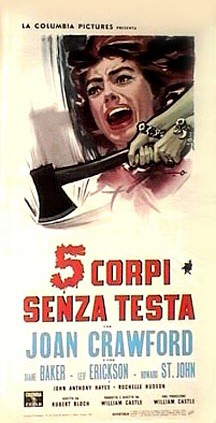
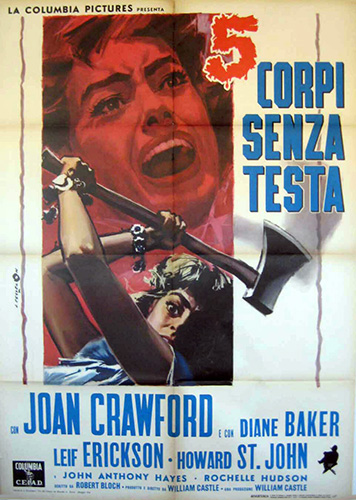
Above: Italian posters. Below: Posters from Australia, Germany, Belgium, Spain.

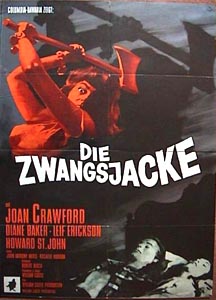
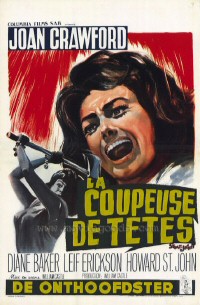
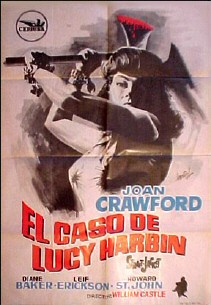
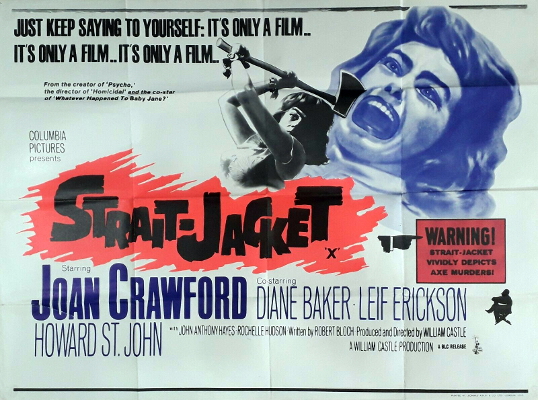
Above: UK quad (40 by 30 inches)
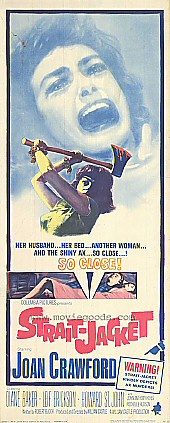
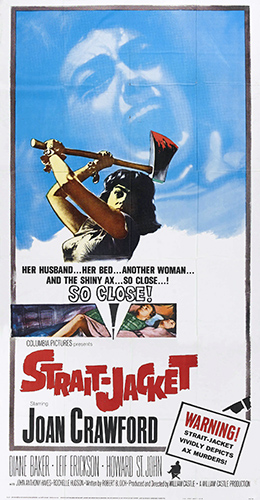
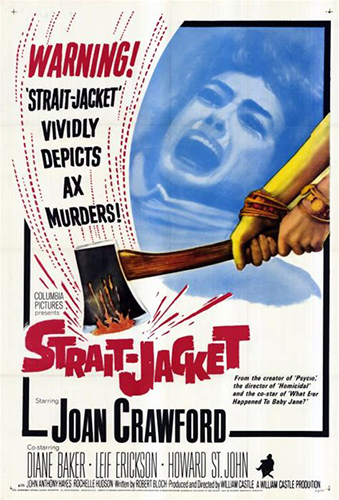
Above: US posters.


Above: Two-sided US advertising poster, 40 x 60 inches.








Above: US lobby cards. Below: German lobby cards.


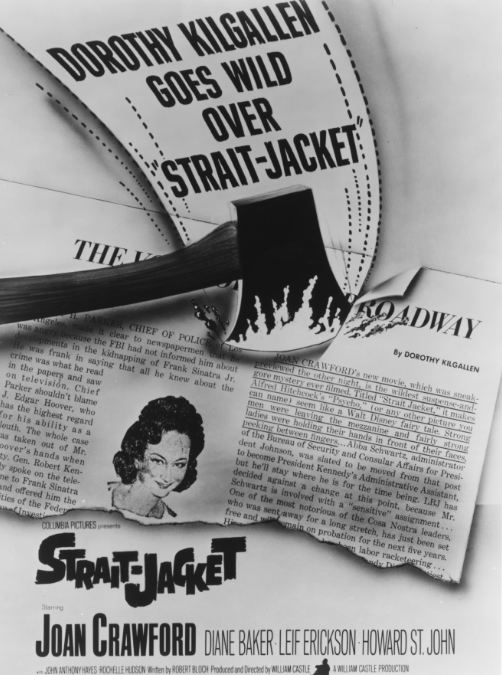
Above: After Dorothy Kilgallen praised Strait-Jacket in her column, director William Castle took out this trade ad featuring her quote.

Above: US banner. 24 x 82 inches.
Below: Danish program cover.


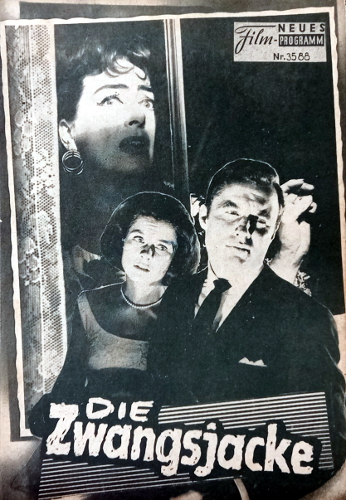

Above: German publicity (left), and Austrian program covers.


Above: Cardboard promo axes.
Below: Left: A 1964 Riverside CA newspaper ad (the film was shot there). Right: 1972 Chicago newspaper ad promoting a TV re-run of the film.


The Best of Everything
